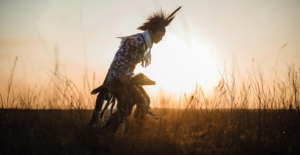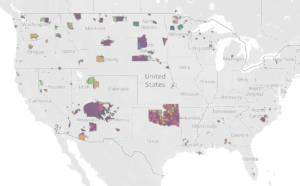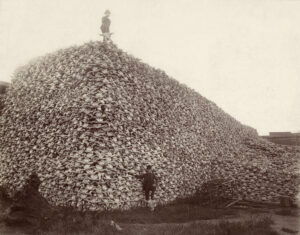By Raven McMullin
Since the inception of the Native Lands Advocacy Project (NLAP), we have been committed to compiling publicly available datasets for the purpose of gaining a fuller understanding of Native American agriculture nationwide—and, more importantly, to compile a comprehensive data source for Native communities to utilize in the protection of their homelands.
In striving towards this mission, a natural focal point has been aggregating the data from the USDA’s Census of Agriculture for American Indian Reservations—first published as a printed report in 2007. Since 2007, our team has swiftly worked to compile and analyze the census data, and we repeated this process with the data published in 2012 and 2017. This evolved into our USDA Census of Agriculture for American Indian Reservations Dashboard, which allows users to analyze the data in new ways that the printed census report, alone, does not immediately allow for. In particular, our dashboard allows users to aggregate the data across all of the reservations uniquely reported, observe added calculations for Non-native farm and ranch operations, and view the census data (for the years 2007, 2012, and 2017) side-by-side to analyze data progressions with greater ease—culminating into one of our most important and timely data sets available on our website.
The census data, presented in this way, exposes a serious disparity in the distribution of agriculture revenue on Native reservations, where nearly 90% of the agriculture revenue produced on Native reservations is captured by Non-native producers. This trend meant that Non-native farmers and ranchers were reaping the benefits of the vast majority of agriculture on Native reservations. However, we also recognize that—within this data—there are stories of ongoing policy initiatives that demonstrate the resilience of Native communities in protecting and managing their own lands and that also demonstrate a reshaping of the preceding narrative.
To shine a light on these stories within the data, we are launching a new blog series titled “Completing the Narrative” to not only discuss the challenges in reservation agriculture but to highlight the creative ways that Native communities are overcoming those challenges.
This chart illustrates a steady increase in Native producer market share for the Tribe in which we see a total increase of $18,145 in market value from 2007 to 2017—amounting to an overall 75.4% increase in Native producer market share! And this increase might be due to a innovative tribal grazing lands policy change.
Our first installment in this new series comes from the Cheyenne River Sioux Reservation in northcentral South Dakota. To set the scene for this story, we will first introduce a chart from our data dashboard demonstrating how conditions for Native producers appear to improve over time on the Cheyenne River Sioux Reservation. The chart below summarizes the Total Market Value of Agricultural Products Sold for the periods of 2007, 2012, and 2017 for the Cheyenne River Sioux Reservation across Native and Non-native producers. This chart illustrates a steady increase in Native producer market share for the Tribe. We see a total increase of $18,145 in market value from 2007 to 2017—amounting to an overall 75.4% increase in Native producer market share! And this increase might be due to innovative tribal grazing lands policy changes.
Chart: NLAP’s Census of Agriculture Data Dashboard filter for Cheyenne River Reservation
To learn more about the possible drivers behind this change, we reached out to Zach Ducheneaux, former tribal council member and former director of the Intertribal Agriculture Council. He recalled the incredible impact of a 2003 grazing ordinance that established a right of first refusal for its Native producers to lease tribal grazing lands—though this policy was enacted well before the USDA began its examination in 2007. The right of first refusal ordinance allowed Native producers to extend their leasing permits before opening up tribal grazing lands for allocation by Non-native producers. The implementation of this policy led to positive increases in Cheyenne River Sioux producer capital and livestock ownership—thereby ensuring that the members of their tribal community are the primary beneficiaries of the growth and activity taking place in their homelands.
Cheyenne River Sioux Reservation: 2003 Grazing Ordinance
The Cheyenne River Sioux Reservation is located within the Northern Great Plains of South Dakota. According to Cheyenne River Sioux’s Department of Game, Fish, and Parks, approximately half of the lands within the Cheyenne River Sioux Reservation are held in trust status, with overall management belonging to the Tribe. The Tribe’s historical account of its traditional lands is as follows:
“The present land base of the Cheyenne River Indian Reservation was established by the 1851 and 1868 Fort Laramie Treaties and the Sioux Act of 1889. Prior to this, the bands placed within this reservation knew no boundary to their territory. They were hunters and traveled frequently in search of their main food source, the sacred American bison or buffalo” (“History,” Cheyenne River Sioux Tribe).
https://www.cheyenneriversiouxtribe.org/
As a third-generation rancher on the same ancestral footprint of land, Zach Ducheneaux describes the landscape of the Cheyenne River Sioux Reservation as not being entirely dissimilar to the lands we enjoy at NLAP’s headquarters in Fort Collins, CO—granted, if you take a few mountains out of the picture. The Cheyenne River Sioux Reservation is blessed with rolling prairie lands, mixed grasslands, cedar river breaks, and much more.
“Prior to the work we did [on the tribal council] in 2003,” said Ducheneaux, “range unit allocations would happen every five years, and [when those five years came], every single range unit was up for open allocation. This meant that whoever wanted to [apply for a permit] could apply—regardless of whether you are established. The challenges that this [precedence] created with the programs and services that are afforded to our producers were significant. For example, if you only have a five-year leasing permit with no right to extend that permit, you are not going to be able to secure financing beyond the remainder of that remit period…you are also not going to be able to enroll in conservation programs within the remainder of that period.”
Open-range unit allocation makes it difficult for tribal members to establish themselves on their own lands and benefit from their own natural resources. Additionally, Ducheneaux shared the challenges that Native farmers faced in attempting to establish land tenure with so many range units of reservation land up for open allocation—especially without a right of first refusal policy afforded to Native producers on the reservation. To address these challenges, the Cheyenne River Sioux tribal council established a 2003 grazing ordinance that allowed for a Native producer (who had 50% or more of their carrying capacity in livestock that they owned) to have the right of first refusal in the grazing lands permitting process— provided that they are 100% abiding by tribal regulations. The right of first refusal policy gave Native producers on Cheyenne River Sioux lands the right to be first-in-line for the opportunity to extend their permits and purchase or lease the land in the future.
“During our first round of range unit applications in 2003,” Ducheneaux personally recounts, “there were approximately 266 range units [on Cheyenne River Sioux], and nearly half of those units were up for open allocation. Now, fast forward to 2018, there were about less than 20 range units up for open allocation because they [Native producers] were able to stock more than 50% of that [range] unit with their own animals [livestock].” Furthermore, the Cheyenne River Sioux Reservation saw a great increase in conservation program participation, producer access to capital, and producer ownership of livestock since the 2003 grazing ordinance. This expansion of Native producers helped the reservation stabilize a stronger community of agriculture.
“During our first round of range unit applications in 2003” Ducheneaux personally recounts, “there were approximately 266 range units, and nearly half of those units were up for open allocation. Now, fast forward to 2018, there were about less than 20 range units up for open allocation because they [Native producers] were able to stock more than 50% of that [range] unit with their own animals.”
Zach Ducheneaux
We were also able to reach out to Fanny Brewer, a technical specialist for the Intertribal Agriculture Council and current Native producer on Cheyenne River Sioux, to learn more about the impacts the ordinance had on the tribe’s economy. Brewer explained that, on top of the benefits that came with shifting agricultural resources back to tribal members, Native producers would also naturally deposit their generated revenue right back into their local community—stabilizing a stronger tribal economy. Conversely, if you had a Non-native producer conducting operations on reservation land, they would often deposit a majority of their revenue outside of the reservation. Moreover, Brewer highlighted a different aspect of the ordinance’s impact: the impact on future generations of Native producers. As a multi-generational producer and rancher, Brewer positively poses the question, “Will our younger generations know how much the [2003 grazing] code has done for this reservation?” By ensuring that Native producers receive a contractual, first right to consider their leasing permits, producers have a greater opportunity to protect their lands for the future of their own families and the future generations of Native American producers.
The success story at Cheyenne River Sioux addresses issues that are common to many Native communities where allotment fractionation makes it incredibly difficult, if not nearly impossible, for Native producers to steward the lands that they reside on. Furthermore, it has been demonstrated in NLAP’s previous blog posts how major federal allotment policies have damaged the existing structures of Native land stewardship and agriculture. However, the aforementioned 2003 grazing ordinance provided an incredible opportunity for Native producers on the Cheyenne River Sioux to establish land tenure and shift agriculture responsibility and benefit back to the tribal community. This is just one of the many stories of how Native Nations exert sovereign protection over their lands as an invaluable and reciprocal resource to the social, emotional, and physical health of their communities. Listening and paying greater attention to Native Nations’ perspectives on the federal data we analyze is necessary for gaining a fuller understanding of the activities taking place on Native lands.
What might this mean for your relations?
Does the information shared in this post resonate with you and/or your Native community? NLAP, through our Native Land Information System (NLIS), works to compile, consolidate, and visualize data and information for Native communities to utilize in their own planning and protection of their homelands. Relating to this particular blog, if you are curious about the share of your tribe’s agricultural revenue, feel free to view our interactive USDA Census of Agriculture for Native American Reservations Dashboard. Our website also hosts many other data resources relating to lost agriculture revenue, land leasing, soil capability, and land covers on Native lands. Please visit our topic page Native Agriculture and Land-Use to view more!
Does your Native community want to participate in the next Census of Agriculture? The census data collected by USDA is what primarily informs policymakers on what programs to support relating to conservation, agri-finance, disaster relief, and agricultural education. We reached out to the National Agricultural Statistics Service (NASS) to find out how Tribes, who want to be included in the Census of Agriculture, can reach out:
- The agriculture census can be completed online at www.agcensus.usda.gov
- For questions or assistance with your form, call (888) 424-7828, or reach out to your local NASS state statistician to discuss the process!
Background on the USDA Census of Agriculture for American Indian Reservations
As a part of a pilot study in 2002, the USDA began conducting a special Census of Agriculture on Native American reservations in Montana, South Dakota, and North Dakota. The USDA then continued to conduct a limited Census of Agriculture on 73 Native American reservations in 2007, and then expanded to include data for 76 reservations in 2012, and finally, data for 73 reservations in 2017. The Census of Agriculture aims to comprehensively account for all farm and ranch operations in the United States, and this data greatly influences federal, state, and local farm policy and program decision making. At the Tribal level, while there are over 500 Native reservations in the contiguous United States, the Census of Agriculture accounts for only 73-76 Native land areas from the years of 2007 to 2017.
Recognizing the importance of the census, we developed an interactive dashboard to make it easier to navigate the data (shown above). Along with showing all the variables from the 2007, 2012, and 2017 the dashboard extends the data by:
1. Including the values for non-native producers vs. just the values for native producers and total.
2. Providing the ability to aggregate the data across more than one reservation at a time.
3. View the changes in the values across the 2007, 2012, and 2017 Census’.
One startling statistic the data dashboard reveals is that—of over 76 Native land areas included in the census—87% of the agricultural revenue produced on Native reservations is held by Non-natives. This means that Non-native farmers and ranchers are reaping the benefits of most of the agriculture on Native reservations. If nearly 90% of agriculture revenue on Native reservations is captured by Non-native farmers and ranchers, what might this trend mean for Natives who are attempting to start or expand an agricultural operation on their own reservation? We pondered how tribal policy and community efforts could increase the share of agricultural revenue for Native producers on reservation lands.
In part, the low visibility given to Native farm and ranch operations in the data might be due to Native communities opting-out of the census collection. In order to be included in the Census of Agriculture publication, Tribes must first consent to participate and provide an adequate list of individual farm and ranch producers who are operating on their reservations. While Native communities reserve the right to exert protection over their agriculture however they see fit, tribal input in the Census of Agriculture remains incredibly important to ensure that the data reflects true numbers and needs.
Limitations
*The published census reports only quantify each variable for “Native” and “Reservation Total” and do not report statistics for “Non-native.” Whether it’s intentional or not, we feel this conceals valuable information about the extreme disparity that exists between Native and Non-native agricultural operations on Native American reservations. To highlight this disparity, we have included a provisional calculation for “Non-native” producers, making it possible to analyze the racial disparity in agriculture on Native lands.
*It should also be noted that, while this is the most current and most complete national dataset on reservation agriculture, the data collected by the USDA is focused primarily on commodity agriculture; therefore, it is not sensitive enough to adequately examine domestic production and/or small-scale food sovereignty initiatives, food market successes, or other agricultural sovereignty efforts that might positively impact the reservation agriculture, economy, and diets.











